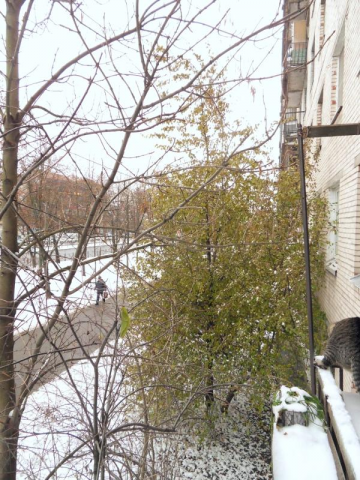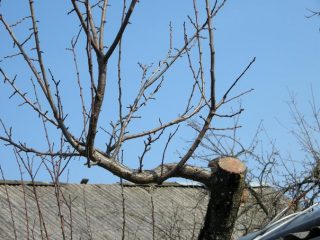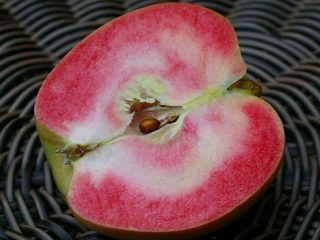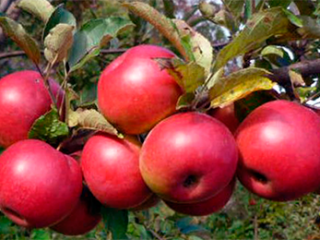Content
Autumn is the golden time of leaf fall. Observant gardeners have long noticed that different species and even varieties begin to shed their leaves at different times. Winter apple varieties remain green longer than summer ones. But it also happens that seedlings or fruit-bearing trees meet the winter with leaves. Why didn’t the apple tree shed its leaves for the winter, and what measures should be taken? Does this fit into the norm and what does it signal?
Briefly about the physiology of leaf fall
Before thinking about the causes and consequences of the apple tree’s reluctance to part with its leaves in the fall, let’s remember from the school botany course why this even happens. First, the leaf loses its green color, which is due to the destruction of chlorophyll. Why is it being destroyed? Due to lack of water and shortening daylight hours in autumn. Important processes occur in leaves that change color: the outflow of nutrients into the parenchyma and the formation of a cork layer at the base of the petiole. When these processes are completed, the leaf falls off.
Over the course of evolution, deciduous plants have adapted to harsh, prolonged cold weather. By changing day length and temperature, trees “determine” when to begin preparing for winter.Under natural conditions, healthy trees shed their old leaves in a timely manner, which signals the end of the growing season and going into deep sleep.
If the apple tree shed its yellowed leaves in a timely manner, then be sure that all growth processes in it have stopped, the bark of the young growth has matured and its frost resistance is at a high level. If the leaves have not fallen, then peeling and cutting will not solve the problem. You need to help the apple tree in a different way.
What can cause failed leaf fall?
Understanding the physiology of leaf fall, a gardener should not consider its absence to be the norm, even if this situation has been repeated for several years and the tree safely endures the winter.
In addition to external manifestations (freezing of young growth), typical in regions with harsh winters, there may be hidden deviations, expressed in low yield and fragility of the apple tree itself.
Why does the leaf remain green and hold tightly to the petiole even in late autumn? In the tree, growth processes are still active and leaf nutrition continues, since there is a need for photosynthetic products. The reasons for this phenomenon may be the following:
- violation of the fertilizer application schedule: overfeeding with nitrogen in the second half of summer or introducing humus into the tree trunks in the fall provokes active growth of green mass; seedlings planted in well-filled holes lengthen their growing season and do not have time to go dormant before the cold weather;
- incorrect watering scheme or heavy rains in the fall after a dry summer: excess moisture in the soil does not allow the apple tree to slow down its growth; in a warm autumn, a second wave of shoot growth is possible;
- inconsistency of the apple tree variety with the growing region: southern varieties with a long growing season, planted in the Middle Zone or Volga region, simply do not have time to complete it by winter;
- a natural anomaly when winter comes early with a sharp drop in temperature.
In addition to the listed reasons for the disruption of leaf fall, foliage can remain on the apple tree due to disease. For example, seedlings and individual branches of fruiting apple trees affected by fire blight turn black along with the leaves and become waxy. At the same time, the leaves hold tightly and do not fly off.
Partial leaves can remain on apple trees until late autumn, especially in winter varieties, but with the first winter winds they fly away. This phenomenon is normal and should not be alarming.
Common gardening mistakes
Unfortunately, summer residents notice too late that apple tree seedlings are unprepared for winter. In the fall, they start going to the dacha less often (due to bad weather), and after harvesting root crops they stop altogether. The result: we arrived at the dacha after the first snow to cover the flowers, and there was a green garden. So what should I do?
If snow has already fallen and the leaves are frozen, then it is better to do nothing and hope for a mild winter. It would be a mistake to take the pruning shears and cut off the frozen leaves or, even worse, to pick them off by hand. This will not help the apple tree in any way, you will exhaust yourself and leave damage to the young bark at the place where the petiole is attached. You should not pick off leaves even in the fall before frost, since they are only a sign and not the cause of low winter hardiness. If it is still possible to build a shelter for apple tree seedlings, then this will be more useful.
For an adult apple tree, overwintering with leaves and unripe growth is only fraught with freezing.Young trees and seedlings may die from frost or dry out in early spring. Therefore they require special attention.
Some gardeners recommend treating apple tree leaves in the fall with a high concentration of pesticides in order to provoke a discharge. This measure is unacceptable, since the tree gets severely burned, and the leaves fall off as a result of severe stress. Such “help” will negatively affect the winter hardiness of the apple tree. It is possible to treat with chemicals, but they must have a specific purpose. We will look at them below.
What actions to take
There are several recommendations that will help avoid problems with leaf fall in an apple tree:
- do not plant capricious southern varieties of apple trees on your site, purchase seedlings from local gardeners;
- do not delay planting seedlings, give them time to prepare for winter;
- when planting in autumn, add only phosphorus and potassium to the planting hole under the apple tree, and leave organic matter and nitrogen fertilizers for the spring;
- follow the rules for applying fertilizers and do not overfeed, an adult apple tree grows well on soils with an average level of fertility and without fertilizers;
- under unfavorable conditions, fertilize the apple tree with phosphorus-potassium fertilizers.
If in the fall you see that your trees or seedlings are not going to shed their leaves, then you need to take measures to additionally protect the apple tree from low temperatures and winter winds. Prepare a frame for attaching the covering material.
Cover the trunk circles of apple tree seedlings with a 10-centimeter layer of mulch from pine needles, peat, mown grass or dry leaves without infection. Decorative bark chips will perform an aesthetic and protective function.
It is advisable to wrap the trunk of an apple tree seedling with covering material up to the crown. If the seedlings are annual and compact, wrap the entire crown with leaves. You can use burlap or agrofibre.
How to properly cover a young apple tree, watch the video:
This procedure will help the apple tree withstand frost. If there is a lot of snow, then sprinkle it on the trees. Since the leaves remain on the branches, the cover must be removed immediately after positive temperatures have been established, so that the buds do not rot.
Features of using preparations for shedding leaves
If at the beginning of autumn apple trees do not show signs of slowing down growth processes (yellowing of leaves, lignification of young shoots, differentiation of buds), then special preparations based on growth regulators can be used.
In plants, ethylene is synthesized to activate leaf shedding. Powerful natural growth inhibitors are coumarin and abscisic acid.
Synthetic inhibitors designed to remove leaves are called defoliants. Ethylene-based defoliants were previously used in fruit growing.
Do not use outdated toxic preparations to treat apple trees in the fall: hulk, etafon, etrel, magnesium chlorate, desitrel and others. Such treatments will do more harm than good. Experts include damage to growth points, marginal burns and decreased viability as side effects.
In industrial nurseries, copper chelate and sitrel (silicon-based) are used to prepare apple tree seedlings for digging. Spraying is carried out only after treating trees with sulfur-containing preparations.The effectiveness of the defoliant will depend on the condition of the tree, weather conditions during the growing season and during the dormant period.
Penetrating into plant tissue through the leaf, defoliants accelerate the aging process, destroy chlorophyll in the leaves and cause artificial leaf fall. Treatment with drugs should be carried out at the beginning of the natural aging process of the leaf to accelerate it. Earlier use results in decreased effectiveness.
Defoliation is also carried out during forced replanting of an adult tree. In any case, it is not recommended to exceed the dosages specified by the manufacturer. Failure to follow the instructions will lead to kidney death and growth arrest. With a mild degree of damage in the spring, there is a delay in bud opening and, as a consequence, a shift in the growing season and the leaves go into winter again.
In recent years, due to the vagaries of nature, the foliage often remains on the apple tree in winter, regardless of the growing region. But not only the natural factor is the reason. Often, reluctance to study zoned varieties or the deliberate purchase of large-fruited and sweet apple trees of southern varieties leads to the death of the garden.
The remaining green foliage signals the apple tree’s low winter hardiness, so the gardener’s main task is to increase winter hardiness and preserve shoots and buds. Let us note once again that partial leaves with lignified shoots should not be alarming. For some varieties of apple trees, this phenomenon is especially typical, for example, for the widespread Antonovka.
















What to do in the spring if the apple tree has already overwintered with its leaves, cut off the strong leaves themselves in sections? And raspberries too, thank you
Good afternoon, dear Nurlay!
There is no need to cut off leaves that the apple tree has not dropped in the fall. They will fall off on their own as the weather warms up. Now you only need to observe how your apple tree survived the winter frosts. If everything is in order and the kidneys begin to swell in due time, then nothing terrible has happened. The foliage will fall off on its own as soon as the buds begin to bloom.
Raspberry leaves should also not be trimmed or picked off.
And further. There is a lot of advice online from would-be gardeners that in such cases it is necessary to urgently treat trees with pesticides. Under no circumstances should this be done. You can not only harm your trees, but also destroy them.
We wish you high harvests!